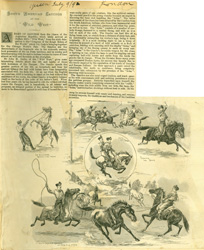Title: South American Gauchos at the "Wild West"
Periodical: The Queen
Date: July 9, 1892
More metadata
SOUTH AMERICAN GAUCHOS AT THE "WILD WEST."
A BAND OF GAUCHOS from the Llanos of the Argentine Republic, which lately arrived at Buffalo Bill's "Wild West," form the sixth delegation to the "Congress of the Rough Riders of the World," which Col. Cody is bringing together for the Chicago World's Fair. The Gauchos are the descendants of the Spaniards who in the sixteenth century took possession of the La Plata territory, and by mixing and intermarrying with the native Indians became in course of time almost as wild and ferocious as the aborigines.
Mr John M. Burke, of the "Wild West," gives some interesting details about the life and habits of these wild horsemen of the Pampas. The Gaucho spends the greater portion of his life on horseback, and from his earliest infancy the half wild horses have been inseparably associated with his daily life. At an age when the English or American child is learning to stand on his feet without the assistance of his nurse, the infant Gaucho is taught to balance itself on the backs of the colts of his father's herd. When but four years old, he has learned to ride the wildest colt that roams the Pampas, and is henceforth, to all intents and purposes, an integral portion of the animal he bestrides, no more to be dismounted against his will than if he and the horse were really parts of one creature, like the mythical centaur. By constant practice the young Gaucho becomes an expert in throwing the lasso and handling the "bolas." The latter instrument of the chase has been adopted by the Gauchos from the South American Indians, who from time immemorial used it for the capture of ostriches, guanacos, and other big game, as well as in war. The "bolas" consists of a number of rawhide thongs, fastened to a central thong, and with an iron ball at each of the ends. The Gaucho can hurl this at a flying horse, cow, or ostrich from a distance of sixty feet, and, by inextricably entangling his victim's legs, bring it down helplessly. It is a most exciting sight to see a troop of Gauchos in pursuit of a herd of wild animals or a flock of ostriches, hurling with unerring skill the deadly "bolas," and bringing one of the fleeing quarry to earth at every cast. The "bolas" is the Gaucho's favourite weapon for the chase or fighting in war, while the lasso is used for singling out and capturing half-wild horses and cattle from the herds the gaucho has in charge. When the Dictator Rosas many years ago conquered Buenos Ayres, his success was largely due to the terror inspired by the reputation of his horde of Gauchos and Pampas Indians. On their approach a panic seized the inhabitants, who made no resistance, being completely terrorised into submission by the presence of the "bolas"-throwing wild horsemen.
The Gauchos are also most expert trailers, and track game or foe with consummate skill and untiring persistence across the pathless pampas. Entirely dependent upon himself, the Gaucho makes nearly everything connected with his "outfit," including even the rude saddle from raw hide, the lasso, the "bolas," and his leather stockings without heel or sole. In his camp he amuses himself with music and dancing, and retains, in many respects, the traditions and tendencies of his Castilian ancestors.
[drawings]THE BUCKJUMPER REFUSES TO BE THROWN
THROWING THE LASSO
THROWING THE BOLAS
RIDING A WILD HORSE
SOUTH AMERICAN GAUCHOS LASSOING WILD HORSES
Title: South American Gauchos at the "Wild West"
Periodical: The Queen
Source: McCracken Research Library, Buffalo Bill Center of the West, William F. "Buffalo Bill" Cody Collection, MS6, MS6.3778.081.01 (1892 London)
Date: July 9, 1892
Topics: Congress of Rough Riders
Keywords: Bolas Clothing and dress Ethnic costume Exhibitions Folk dancing Folk music Gauchos Horsemanship Horsemen Indians of South America Lasso Scrapbooks Traveling exhibitions Wild horses World's Columbian Exposition (1893 : Chicago, Ill.)
People: Burke, John M., 1842-1917
Places: Buenos Aires (Argentina) Earl's Court (London, England) London (England) Pampas (Argentina)
Sponsor: This project is supported in part by a grant from the National Endowment for the Humanities and the Geraldine W. & Robert J. Dellenback Foundation.
Editorial Statement | Conditions of Use
TEI encoded XML: View wfc.nsp12542.xml
Back to top
